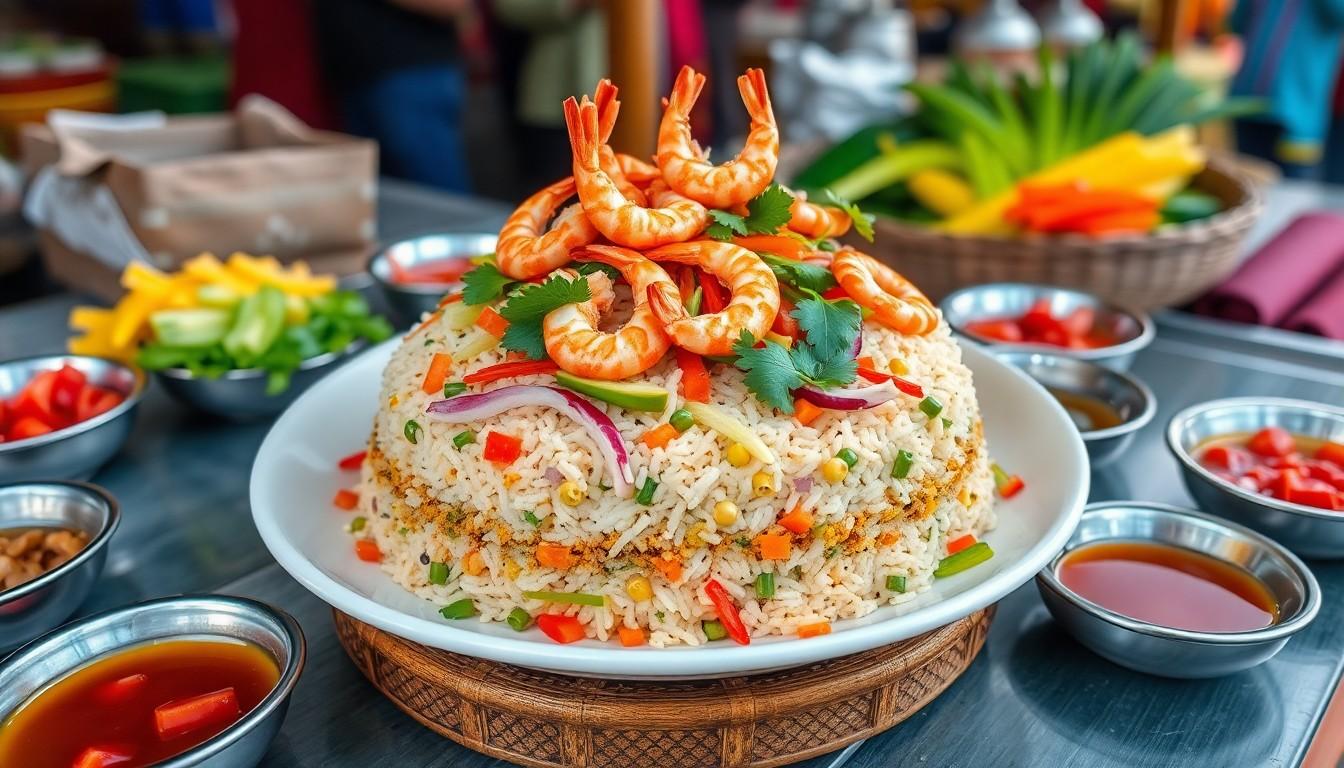
Food Named Hingagyi in Myanmar: Discover This Flavorful Culinary Treasure
In the vibrant culinary landscape of Myanmar, hingagyi stands out like a peacock in a flock of pigeons. This delightful dish, often overshadowed by more famous fare, is a hidden gem that deserves the spotlight. Imagine a fusion of flavors that dances on your taste buds, leaving you craving more with every bite. If you think you’ve tasted it all, think again!
Overview of Hingagyi
Hingagyi features a unique combination of flavors and textures, reflecting Myanmar’s rich culinary heritage. This traditional dish consists of layers of rice and various toppings, often including a mix of vegetables, spices, and proteins. Variations exist, allowing for seasonal ingredients to shine.
It typically incorporates shrimp paste, lending a distinct umami note that enhances the overall taste. Chefs prepare this dish with care, ensuring each component harmonizes perfectly. Locals often enjoy hingagyi during special occasions, celebrating its cultural significance.
The dish pairs well with a variety of side condiments, such as pickled vegetables and sauces, adding further depth. In many households, it serves as a comfort food, evoking nostalgia and warmth. Ingredients play a crucial role, with each element contributing to the dish’s complexity.
Hingagyi commonly features in food festivals and gatherings, showcasing Myanmar’s vibrant food scene. Enthusiastic food lovers often discover this hidden gem, appreciating its delightful flavors. Exploring hingagyi reveals the craftsmanship of Burmese cuisine, where each bite tells a story.
Through its unique preparation and presentation, hingagyi stands out among other local dishes. Diners appreciate its rich flavors and satisfying texture, making it worth seeking out. The popularity of hingagyi continues to grow, inviting more individuals to experience this culinary treasure.
History of Hingagyi

Hingagyi holds a special place in Myanmar’s culinary heritage. Its roots trace back to the various ethnic communities that enrich the region’s food culture.
Origins and Cultural Significance
Culinary experts often link hingagyi to the Chinese influence in Myanmar. The dish represents a blend of indigenous flavors with traditional Chinese cooking methods. Historical accounts suggest that this fusion arose from trade and cultural exchanges. Celebrations commonly feature hingagyi, showcasing its role as a comfort food that evokes shared memories among families. The dish’s diverse toppings reflect the country’s geography and agricultural products, enhancing its cultural significance. As a result, hingagyi has become a symbol of unity and festivity in Myanmar.
Evolution Over Time
Hingagyi has evolved significantly since its inception. Modern interpretations of the dish now include a variety of proteins such as chicken, fish, or tofu, catering to different dietary preferences. Changes in farming and production have influenced ingredient availability, allowing chefs to experiment with new flavors and textures. Street food vendors play a vital role in popularizing hingagyi, introducing it to a broader audience. Festivals often feature innovative takes on this traditional dish, further driving its evolution. Consequently, hingagyi maintains its relevance while celebrating its rich heritage throughout the years.
Ingredients Used in Hingagyi
Hingagyi’s distinct taste comes from a combination of fresh and flavorful ingredients. The dish centers around rice, which serves as the foundation for layering other components.
Main Components
Rice forms the base layer of hingagyi, cooked to achieve the perfect texture. Commonly included proteins like chicken, pork, or shrimp add richness. Vegetables such as carrots, peas, and onions contribute freshness. Aromatic herbs like cilantro and spring onions enhance the flavor profile. Shrimp paste, essential for umami, ties these elements together. The careful selection of ingredients ensures a satisfying meal.
Unique Flavor Profiles
Hingagyi’s flavor complexity stems from balancing sweet, salty, and savory notes. Spices such as turmeric and chili powder provide warmth and depth. The combination of rice and toppings creates layers of taste. Fresh vegetables introduce a crunchy texture that complements softer elements. Shrimp paste offers a distinctive umami kick. Each bite reflects the dish’s cultural significance, showcasing the culinary traditions of Myanmar. Various interpretations highlight regional variations, ensuring every version of hingagyi possesses unique traits.
Preparation Methods
Hingagyi showcases a variety of preparation methods that reflect both tradition and modern influences. Mastering these techniques enhances the dish’s unique profile.
Traditional Techniques
Traditional preparation of hingagyi involves steaming layers of seasoned rice, vegetables, and proteins. Cooks start by cooking the rice with spices for added flavor, then layer it with ingredients like marinated chicken or shrimp. Steaming allows the flavors to meld, resulting in a rich umami taste. Utilizing fresh herbs and vegetables contributes to the dish’s vibrant character. Serving hingagyi with side condiments enriches the dining experience, balancing flavors and adding texture.
Modern Variations
Modern variations of hingagyi incorporate diverse ingredients to cater to contemporary palates. Chefs experiment with quinoa, brown rice, and alternative proteins like tofu or fish. Certain recipes feature innovative sauces, enhancing the dish’s flavor profile. Influenced by global cuisines, some preparations include ingredients like avocado or spicy aioli. Street vendors often adopt creative twists, including fusion toppings that appeal to younger generations. Each adaptation reflects the evolving culinary landscape while maintaining the essence of this beloved dish.
Serving Suggestions
Hingagyi presents numerous options for enhancing its enjoyment. Each aspect contributes to a multifaceted dining experience.
Accompaniments
Pairing hingagyi with various condiments elevates its flavors. Pickled vegetables add a zesty crunch, helping to balance the dish’s savory notes. Additionally, fried shallots introduce a delightful texture. Various sauces, such as chili oil or garlic sauce, provide an extra kick. Many enjoy adding a squeeze of lime for brightness. These sides complement the umami richness of hingagyi, creating a harmonious plate.
Popular Pairings
Hingagyi shines alongside specific beverages and dishes. Many prefer pairing this rice dish with Myanmar’s traditional tea, enhancing the overall experience. Including side dishes like samosas or spring rolls introduces further contrast and interest. For dessert, sweet treats like mohingya or coconut sticky rice create a satisfying end to the meal. Regional variations often emerge when people explore pairing hingagyi with locally sourced ingredients, reflecting the cultural diversity found within Myanmar. These pairings showcase the adaptability and appeal of hingagyi within the culinary landscape.
Conclusion
Hingagyi stands as a testament to Myanmar’s rich culinary heritage. Its blend of flavors and textures captures the essence of the country’s diverse food culture. As it continues to evolve with modern influences and creative interpretations, hingagyi remains a beloved comfort food for many.
Whether enjoyed at family gatherings or food festivals, this dish fosters connections and shared memories among those who savor it. With its unique taste and adaptability, hingagyi invites food enthusiasts to explore the depths of Myanmar’s culinary treasures. Embracing this dish not only enriches the dining experience but also celebrates the vibrant traditions that shape the nation’s cuisine.


